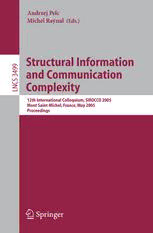
Structural Information and Communication Complexity: 12 International Colloquium, SIROCCO 2005, Mont Saint-Michel, France, May 24-26, 2005. Proceedings PDF
Preview Structural Information and Communication Complexity: 12 International Colloquium, SIROCCO 2005, Mont Saint-Michel, France, May 24-26, 2005. Proceedings
Lecture Notes in Computer Science 3499 CommencedPublicationin1973 FoundingandFormerSeriesEditors: GerhardGoos,JurisHartmanis,andJanvanLeeuwen EditorialBoard DavidHutchison LancasterUniversity,UK TakeoKanade CarnegieMellonUniversity,Pittsburgh,PA,USA JosefKittler UniversityofSurrey,Guildford,UK JonM.Kleinberg CornellUniversity,Ithaca,NY,USA FriedemannMattern ETHZurich,Switzerland JohnC.Mitchell StanfordUniversity,CA,USA MoniNaor WeizmannInstituteofScience,Rehovot,Israel OscarNierstrasz UniversityofBern,Switzerland C.PanduRangan IndianInstituteofTechnology,Madras,India BernhardSteffen UniversityofDortmund,Germany MadhuSudan MassachusettsInstituteofTechnology,MA,USA DemetriTerzopoulos NewYorkUniversity,NY,USA DougTygar UniversityofCalifornia,Berkeley,CA,USA MosheY.Vardi RiceUniversity,Houston,TX,USA GerhardWeikum Max-PlanckInstituteofComputerScience,Saarbruecken,Germany Andrzej Pelc Michel Raynal (Eds.) Structural Information and Communication Complexity 12th International Colloquium, SIROCCO 2005 Mont Saint-Michel, France, May 24-26, 2005 Proceedings 1 3 VolumeEditors AndrzejPelc UniversitéduQuébecenOutaouais Départementd’informatique Gatineau,QuébecJ8X3X7,Canada E-mail:[email protected] MichelRaynal UniversitédeRennes1,IRISA CampusdeBeaulieu,AvenueduGeneralLeclerc,35042Rennes,France E-mail:[email protected] LibraryofCongressControlNumber:Appliedfor CRSubjectClassification(1998):F.2,C.2,G.2,E.1 ISSN 0302-9743 ISBN-10 3-540-26052-8SpringerBerlinHeidelbergNewYork ISBN-13 978-3-540-26052-3SpringerBerlinHeidelbergNewYork Thisworkissubjecttocopyright.Allrightsarereserved,whetherthewholeorpartofthematerialis concerned,specificallytherightsoftranslation,reprinting,re-useofillustrations,recitation,broadcasting, reproductiononmicrofilmsorinanyotherway,andstorageindatabanks.Duplicationofthispublication orpartsthereofispermittedonlyundertheprovisionsoftheGermanCopyrightLawofSeptember9,1965, initscurrentversion,andpermissionforusemustalwaysbeobtainedfromSpringer.Violationsareliable toprosecutionundertheGermanCopyrightLaw. SpringerisapartofSpringerScience+BusinessMedia springeronline.com ©Springer-VerlagBerlinHeidelberg2005 PrintedinGermany Typesetting:Camera-readybyauthor,dataconversionbyScientificPublishingServices,Chennai,India Printedonacid-freepaper SPIN:11429647 06/3142 543210 ......................................... ............................................. .................................................. .............. ..................................... L(h,k) ................................ ............................................... ............... ....... .................................... ................................................ .............................................. ............................. ............................. ............................................ .............................................. .............................. ................................... ............................................. ................................. ................................. .................................... .......... ................................................... Cellular Networks: Where Are the Mobile Users? (Invited Talk) Amotz Bar-Noy CUNY, New York Abstract. Mobilesareroaminginacellularnetwork.Unlesstheyreport their new location each time they cross boundaries of cells, the system must conduct a search operation to find their exact location. Reporting new locations by mobiles consumes expensive up-link communication lines. Therefore, in current and future cellular networks, at each point in time for any particular mobile, the system knows only a zone of cells containing the one cell which is the location of this mobile. For this zone, the system maintains a profile that predicts the exact location of the mobile by associating a probability with each cell in the zone. An efficient search should optimize usage of down-link communication lines and the time needed to find the mobile. This model gives rise to many optimization problems. This talk dis- cusses some of them. We first describe the optimal dynamic program- ming solution that finds a mobile that is located in a zone of n cells in no more than D rounds. This solution assumes an a priori knowledge of the mobile’s profile. We then present solutions in which the system develops a mobile’s profile while searching for that mobile more than once. The above solutions are for locating one mobile. Next, we address searchoperationsinvolvingmmobileswheremcanbegreaterthanone. Oneexampleisthecallconferencesearchinwhichthesystemmustfind allthemmobiles.Anotherexampleistheyellowpagessearchwherethe searchisoveronceoneoutofthemmobilesisfound.Findinganoptimal solutiontotheconferencecallproblemisNP-hard.Wethereforepresent anefficientapproximationsolution.Fortheyellowpagesproblemwedis- cuss work in progress. We conclude with the privacy issue by exploring thetradeoffbetweentheaccuracyoftheprofilesandtheefficiencyofthe optimal solutions that are based on these profiles. A.PelcandM.Raynal(Eds.):SIROCCO2005,LNCS3499,p.1,2005. (cid:2)c Springer-VerlagBerlinHeidelberg2005
